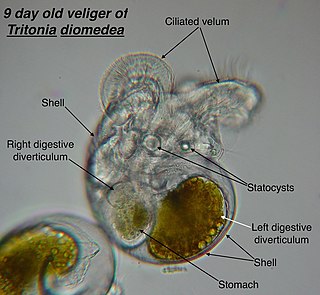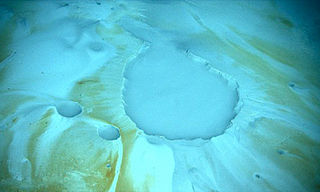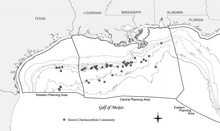
A cold seep is an area of the ocean floor where hydrogen sulfide, methane and other hydrocarbon-rich fluid seepage occurs, often in the form of a brine pool. Cold does not mean that the temperature of the seepage is lower than that of the surrounding sea water. On the contrary, its temperature is often slightly higher. The "cold" is relative to the very warm conditions of a hydrothermal vent. Cold seeps constitute a biome supporting several endemic species.

A veliger is the planktonic larva of many kinds of sea snails and freshwater snails, as well as most bivalve molluscs (clams) and tusk shells.

Eptatretus springeri, the Gulf hagfish, is a bathydemersal vertebrate which lives primarily in the northeastern Gulf of Mexico. It has been observed feeding at and around brine pools: areas of high salinity which resemble lakes on the ocean floor that do not mix with the surrounding water due to difference in density. The high salt content, approximately 200 ppt compared to 35 ppt for standard seawater, creates a buoyant surface which renders oceanic submersibles unable to descend into the pool. It is believed that the inside of the pools only supports microbial life, while the majority of macroscopic life, such as methane-utilizing mussels, exists on the edges. The Gulf hagfish feeds on the primary producers of these environments, as well as other predators.

Rapana venosa, common name the veined rapa whelk or Asian rapa whelk, is a species of large predatory sea snail, a marine gastropod mollusc or whelk, in the family Muricidae, the rock shells.

A brine pool, sometimes called an underwater lake, deepwater or brine lake, is a volume of brine collected in a seafloor depression. The pools are dense bodies of water that have a salinity that is three to eight times greater than the surrounding ocean. Brine pools are commonly found below polar sea ice and in the deep ocean. Those below sea ice form through a process called brine rejection. For deep-sea brine pools, salt is necessary to increase the salinity gradient. The salt can come from one of two processes: the dissolution of large salt deposits through salt tectonics or geothermally heated brine issued from tectonic spreading centers.

The flamingo tongue snail is a species of small but brightly colored sea snail, a marine gastropod mollusk in the family Ovulidae, the ovulids, cowry allies or false cowries.

Abyssochrysidae is a family of sea snails, marine gastropod mollusks in the clade Caenogastropoda.

Provannidae is a family of deep water sea snails, marine gastropod mollusks in the superfmaily Abyssochrysoidea.
The sensory organs of gastropods include olfactory organs, eyes, statocysts and mechanoreceptors. Gastropods have no sense of hearing.

Vitta usnea is a species of freshwater snail with an operculum, an aquatic gastropod mollusk in the family Neritidae, the nerites.
Strubellia paradoxa is a species of freshwater slug, a shell-less freshwater gastropod, an aquatic gastropod mollusk within the clade Acochlidiacea.

Vitta virginea, the virgin nerite, is a species of sea snail, a marine gastropod mollusk in the family Neritidae.
Cordesia provannoides is a species of sea snail, a marine gastropod mollusk in the family Provannidae.

Ifremeria nautilei is a species of large, deepwater hydrothermal vent sea snail, a marine gastropod mollusk in the family Provannidae, and the only species in the genus Ifremeria. This species lives in the South Pacific Ocean

Provanna sculpta is a species of sea snail, a marine gastropod mollusk in the family Provannidae.

Bathymodiolus childressi is a species of deepwater mussel, a marine bivalve mollusk species in the family Mytilidae, the mussels.
Crepidula ustulatulina is a species of small sea snail, a slipper snail, a marine gastropod mollusk in the family Calyptraeidae, the slipper snails or slipper limpets, cup-and-saucer snails, and Chinese hat snails.

Macrostrombus costatus, formerly known as Strombus costatus and Lobatus costatus, or commonly known as the milk conch, is a species of large sea snail, a marine gastropod mollusk in the family Strombidae, the true conchs. They are an edible species and important food source for the inhabitants of where they are found. Conchs are most notable for their medium to large-sized ornamental shells. Milk conchs are dispersed among the tropical waters of the Atlantic Ocean, along the coasts and islands of North, Central, and South America.

Gigantidas tangaroa is a species of deep-sea mussel, a marine bivalve mollusk in the family Mytilidae, the mussels.

Bathymodiolus platifrons, described by Hashimoto and Okutani in 1994, is a deep-sea mussel that is common in hydrothermal vents and methane seeps in the Western Pacific Ocean.

















